The RWA tokenization market is growing rapidly, institutional attention is increasing, and it is expected to achieve trillion-dollar expansion in the future.
Author: @Moomsxxx
Compilation: Vernacular blockchain
The RWA field is growing at an alarming rate. Just a few days ago, the total value of RWA had just hit a new high, and today it broke this new record.
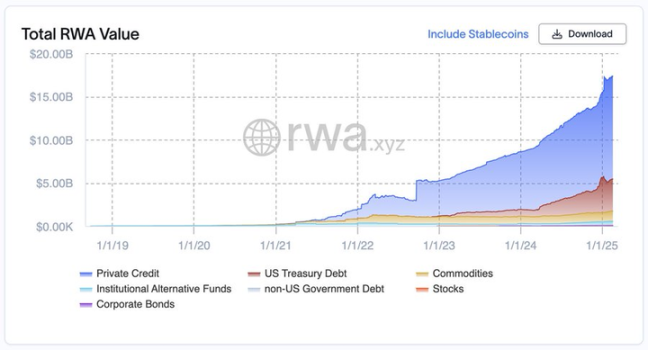
1、RWA TVL
Although many challenges related to privacy solutions, digital identity solutions, interoperability, etc. continue to cause operational friction and become bottlenecks for faster adoptions, the US$2 billion-3 billion raised through chain funds and approximately US$200 billion in stablecoins demonstrate growing interest and adoption in this area of the Web3 industry.
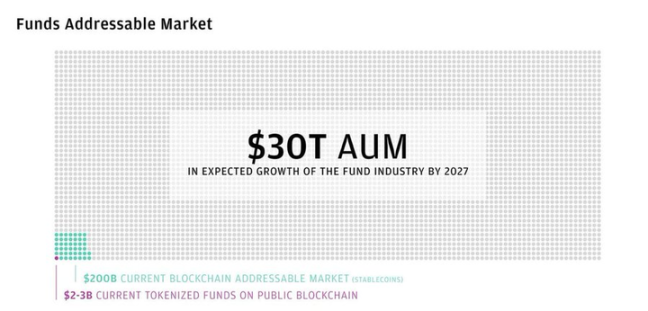
Current token-based funds account for only a small portion of the expected growth of the fund industry in the next few years.
Similarly, growth in the private credit space reflects the growing interest of market participants in opportunities other than Bitcoin, DeFi native earnings, altcoins, and memecoins.
According to @Preqin, the investment scale in the global private credit market is close to US$1.7 trillion, while according to @RWA_xyz, the scale of token-based private credit is only about US$11.9 billion.
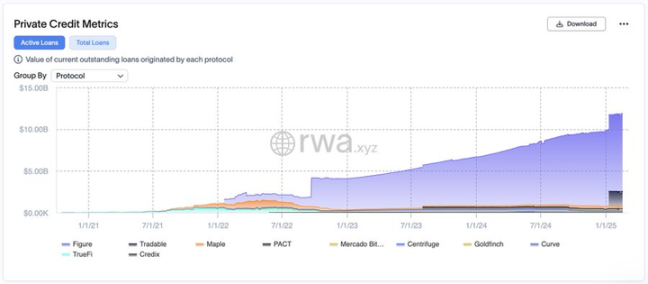
Active Loan Value-Private Credit Markets (Source: RWA.xyz)
Looking deeper into this area, I think it is necessary to mention that the reliability of these loans has changed dramatically since the market crash in 2022, with teams on various platforms becoming more cautious and investing more resources to ensure that the credit issued is of higher quality.
From July 2021 to the end of 2022, metonymy is mainly dominated by crypto trading and market-making companies. As a result, metonyms in this area will collapse in the bear market in 2022.
Since then, growth has mainly come from real-world borrowings dominated by consumer asset-backed securities (such as auto loans, credit card debt, student loans, small commercial loans, etc.), real estate bridging loans, trade finance and other asset classes with less volatility.
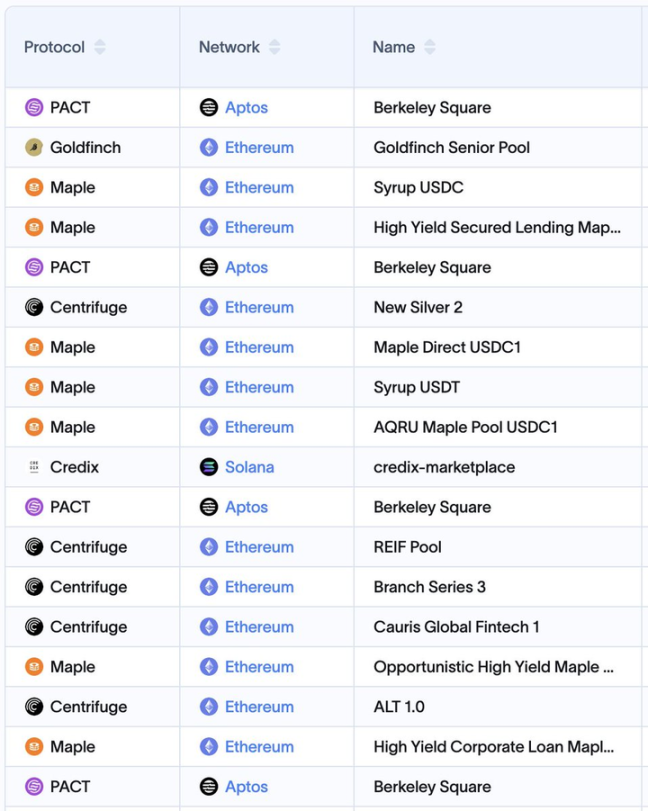
Pool of funds for various RWA transactions
Proof of this is how resilient agreements like @maplefinance behaved in the February 3, 2025 liquidation event-the largest liquidation event in crypto history. For more details, please see the following link: https://x.com/maplefinance/status/1886332880411832514 In addition, over the past three years, the industry has matured considerably and technical solutions have emerged to address regulatory and privacy obligations to further improve this critical area.
2. Opportunity scale
According to @BCG data, tokenization of all mutual funds around the world may unlock an additional $100 billion in annual returns for investors. At the same time,”mature investors”(sorry, not you) make $400 billion by “capturing intraday value changes”(in layman’s terms, day trading). Judging from the historical adoption model of ETFs, it can be reasonably expected that token-based funds will account for 1% of global mutual fund and ETF asset management in the next seven years.
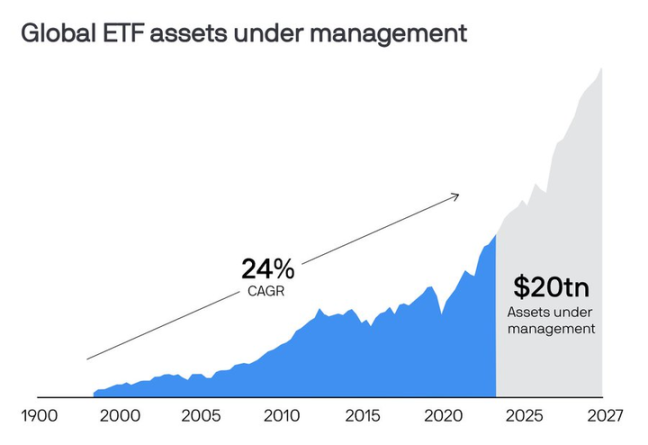
Global ETF Asset Management Scale (Source-J.P. Morgan Asset Management)
This means that by 2030, token-based assets will exceed US$600 billion.
In addition, if regulators allow existing mutual funds and ETFs to be converted into token-based funds (which is simpler than launching a new token-based fund), we could see trillions of dollars in asset management.
Considering that there were similar growth expectations before the launch of the BTC ETF, I think we cannot rule out that these numbers may be too conservative and the actual growth may be surprisingly high.
However, even based on these expectations, we are still talking about at least a 200-fold increase.
Again, from now on, at least a 200-fold increase.
And are you still sitting there feeling upset that you haven’t made any money yet?
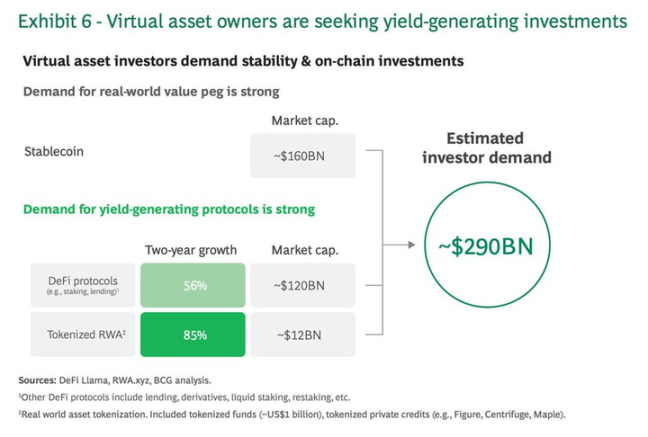
Give me the proceeds, please!
According to this @BCG research, our industry’s investment demand for token-based funds is approximately US$290 billion. This figure includes the needs of stablecoin holders, token-based RWA and DeFi protocols.
I think this number may be high because they consider the growth in the market value of the DeFi protocol market, which comes from a user group with a higher risk appetite, and the investment tendencies of these groups may be different from those who are willing to invest in token-based assets.
It would be more reasonable to consider the growth of DeFi’s total value lockdown (TVL) over the past two years, which would still be a considerable number: US$58.06 billion (Source- @DefiLlama).
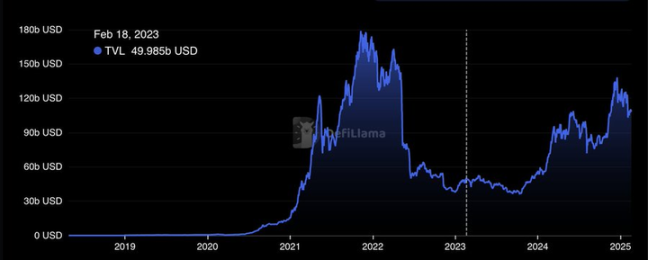
DeFi Total Value Lock (TVL)
In any case, the value proposition of Tokenized Funds and RWA is undeniable. They provide access to real-world investment opportunities, allowing investors to better diversify their portfolios as market dynamics change.
Imagine if you could exchange your chain Tokens for stocks, commodities, and real estate through @Rabby_io in the past few months without having to withdraw cash?
But why does this have to happen? What are the benefits for traditional finance? I haven’t seen much discussion on this topic on Crypto Twitter (CT) recently, especially now amid the craze and controversy over memecoin. We always talk about how traditional finance (tradFi) can enter the Web3 industry and adopt the technology we are building. But why would they do this? Although I plan to write an article dedicated to this topic, here are some key points that explain why traditional finance needs and must adopt the crypto railway:
- Instant settlement, as shown in the chart below, could add approximately $50 billion to investors ‘portfolios every year.
- An additional $33 billion in savings from reduced commissions will eventually flow into investors ‘portfolios.
- Portfolio token-based funds will be easier to lend out.
- Accessible trading tokenization will make it easier for investors to trade assets.

How tokenization improves returns (Source: Boston Consulting Group)
3. Emotions come second, and momentum comes first
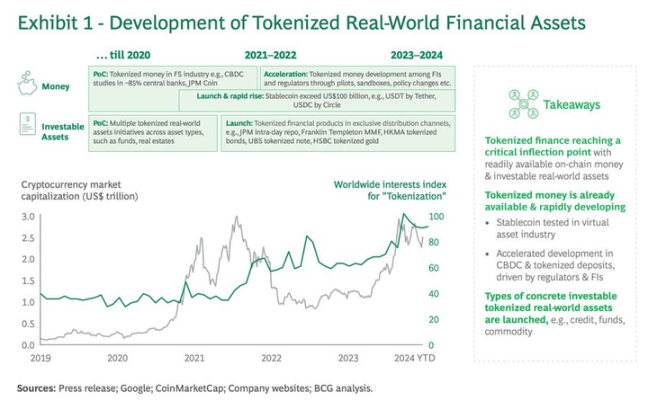
Traditional financial bids, but encrypted Twitter (CT) is cut.
The chart above shows that no matter what the market is like, and especially the mood of CryptoTwitter (CT)(laughter), traditional financial (tradFi) institutions are more interested in tokenization, encryption and blockchain than ever before.
This reminds you how incredible the next few years will be.
Think about it: If traditional financial institutions were interested in tokenization and encryption in the past-even when there was little adoption, unfriendly regulation, and less innovation-why shouldn’t they become extremely bullish now?
In fact, there is only one answer.
You know.
4. What do you think of the encryption market?
Even though market participants ‘sentiment is at historical lows and most discussions focus on @KaitoAI nonsense, Solana’s meme cutting leeks and KOL’s drama, the chart expresses another voice loudly.
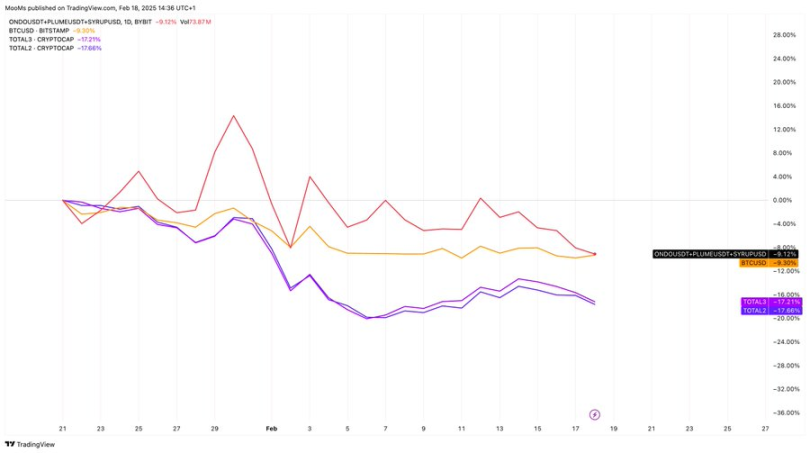
Data does not lie. Since the launch of $TRUMP, RWA’s leading agreements have outperformed, or proven, they are more resilient than the overall altcoin market.
If you included more RWA leading agreements in the index and went back over a longer period of time, the results would be the same.
5. Conclusion
The RWA field is like a huge cake, so far, we have only cut a small piece. However, those who tokenize early will receive a large share, while others will have to pick up the remaining debris. Traditional finance knows this, which is why they are accelerating the process.
I will end with a quote from the @DigitalAssets report: “Looking back at the outlook for 2025, it is clear that investors have not missed the opportunity to join the digital asset wave. In fact, we think we may be entering a new era of digital assets that is expected to span many years-even decades. This era may see digital assets penetrating into various industries-industry, technology, fields, balance sheets, and even at the national level. The key question for investors now is not whether to participate, but how actively they will participate in this change.”



